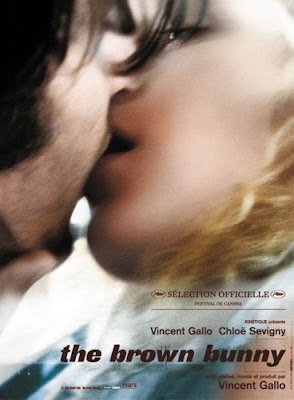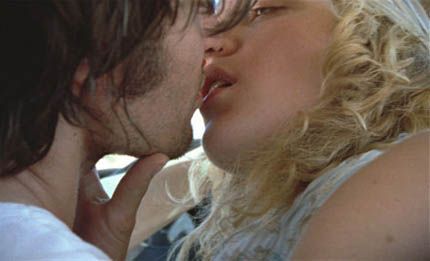← Back to Reviews
in
THE BROWN BUNNY - 2005, Vincent Gallo
Stars: Vincent Gallo, Chloë Sevigny

Reviewing The Brown Bunny is a daunting task, because I feel obligated to justify my views on a deeper level than I normally might. Giving this movie a positive rating is difficult, in the sense that holding a strong opinion about any controversial film is threatening. I am sure that a lot of people were put down for praising Midnight Cowboy and Last Tango in Paris when they were first released, because people are touchy about sex in cinema. The issue of pornography versus art always enters the equation with films like this, and words like “gratuitous”, “exploitive” and “tasteless” are bound to be thrown around.
When reading about The Brown Bunny, I was intrigued to discover that Vincent Gallo is the first one to argue that it is not an art film. He also admits that he uses some of the attributes of porn as a tool in his piece. In finishing his movie on such a shocking, explicit note, he employs a powerful juxtaposition to the quiet subtext preceding it.

The version of the film that I saw was the 92 minute cut released in America. I have never seen the version released at Cannes, and I probably never will. According to popular opinion, that’s a good thing. However, I think a lot of people are approaching this film in the wrong mindset. Anyone who sees The Brown Bunny as “that notorious blowjob movie” is not going to appreciate it on any level beyond shock value. The movie exists as it is for a reason – all the painful, discomforting silence that builds up to that finale is there to amplify the overall resonance.
In a peculiarly disjointed narrative, the film follows the wandering of a protagonist named Bud Clay, although we don’t know his name until close to the ending. He has brief, wistful interactions with several women, but spends most of his time alone. Gallo plays Bud with brilliantly articulated physical suggestions. We can see underlying issues in the way that he carries himself and the visible agony in his face. We follow this character through what often feel like banal, meaningless routines, but their implications become clarified once the closing credits have rolled.

Over-emphasizing the infamous motel scene feels counterproductive, because the sequence isn’t really about sexuality. It’s the most frank and potent depiction of an otherwise hazily sketched character. We learn in one scene what we could only speculate for the majority of the earlier segments in the film. We are presented with haunting regret in the context of a dark fantasy, the dynamics of a broken relationship and possible hints of insanity. Like in Bertolucci’s Last Tango, sex is used not to arouse the audience, but to make them feel uneasy and even ashamed. There’s something unnatural about viewing a scenario like this, and the background information is what makes it so unnerving.
I think Gallo’s film is beautiful in a surprising, exciting and totally original way. We use the word “beautiful” so often that it’s difficult to distinguish the meaning sometimes. On a purely aesthetic level, The Brown Bunny is beautiful even though it breaks rules of composition and, in doing so, stimulates us in ways we don’t expect. Tone is handled masterfully throughout, and we are left with a lingering sense of sadness after the movie is finished.
I think a film like this is potentially alienating. A lot of people will approach it with precise expectations, and most of them will be bored or even repelled by its disregard for convention. I’m not being deliberately iconoclastic when I say that it did a lot for me. It hit me harder than anything I’ve watched in quite a while.
MY RATING: 4.5/5
Stars: Vincent Gallo, Chloë Sevigny

Reviewing The Brown Bunny is a daunting task, because I feel obligated to justify my views on a deeper level than I normally might. Giving this movie a positive rating is difficult, in the sense that holding a strong opinion about any controversial film is threatening. I am sure that a lot of people were put down for praising Midnight Cowboy and Last Tango in Paris when they were first released, because people are touchy about sex in cinema. The issue of pornography versus art always enters the equation with films like this, and words like “gratuitous”, “exploitive” and “tasteless” are bound to be thrown around.
When reading about The Brown Bunny, I was intrigued to discover that Vincent Gallo is the first one to argue that it is not an art film. He also admits that he uses some of the attributes of porn as a tool in his piece. In finishing his movie on such a shocking, explicit note, he employs a powerful juxtaposition to the quiet subtext preceding it.

The version of the film that I saw was the 92 minute cut released in America. I have never seen the version released at Cannes, and I probably never will. According to popular opinion, that’s a good thing. However, I think a lot of people are approaching this film in the wrong mindset. Anyone who sees The Brown Bunny as “that notorious blowjob movie” is not going to appreciate it on any level beyond shock value. The movie exists as it is for a reason – all the painful, discomforting silence that builds up to that finale is there to amplify the overall resonance.
In a peculiarly disjointed narrative, the film follows the wandering of a protagonist named Bud Clay, although we don’t know his name until close to the ending. He has brief, wistful interactions with several women, but spends most of his time alone. Gallo plays Bud with brilliantly articulated physical suggestions. We can see underlying issues in the way that he carries himself and the visible agony in his face. We follow this character through what often feel like banal, meaningless routines, but their implications become clarified once the closing credits have rolled.

Over-emphasizing the infamous motel scene feels counterproductive, because the sequence isn’t really about sexuality. It’s the most frank and potent depiction of an otherwise hazily sketched character. We learn in one scene what we could only speculate for the majority of the earlier segments in the film. We are presented with haunting regret in the context of a dark fantasy, the dynamics of a broken relationship and possible hints of insanity. Like in Bertolucci’s Last Tango, sex is used not to arouse the audience, but to make them feel uneasy and even ashamed. There’s something unnatural about viewing a scenario like this, and the background information is what makes it so unnerving.
I think Gallo’s film is beautiful in a surprising, exciting and totally original way. We use the word “beautiful” so often that it’s difficult to distinguish the meaning sometimes. On a purely aesthetic level, The Brown Bunny is beautiful even though it breaks rules of composition and, in doing so, stimulates us in ways we don’t expect. Tone is handled masterfully throughout, and we are left with a lingering sense of sadness after the movie is finished.
I think a film like this is potentially alienating. A lot of people will approach it with precise expectations, and most of them will be bored or even repelled by its disregard for convention. I’m not being deliberately iconoclastic when I say that it did a lot for me. It hit me harder than anything I’ve watched in quite a while.
MY RATING: 4.5/5
